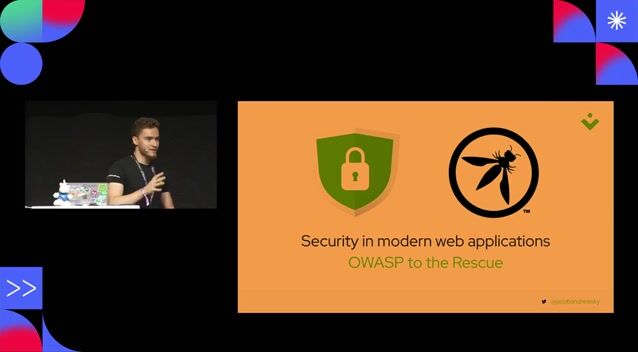Philippe De Ryck
Architecting API Security
#1about 2 minutes
The urgent need for API security from day one
Recent studies show widespread vulnerabilities like hard-coded keys and authorization failures, highlighting the necessity of designing for security from the start.
#2about 1 minute
Focusing on secure architecture over just code
The OWASP API Security Top 10 reveals that many critical risks, like broken authorization, are best addressed through architectural design rather than just secure coding practices.
#3about 2 minutes
A typical API architecture overview
A common API architecture consists of clients, an API gateway acting as a single entry point, and various backend APIs or microservices handling specific responsibilities.
#4about 6 minutes
Why perimeter security is no longer enough
A compromised internal service, such as a vulnerable image processor, can breach the entire trusted zone, demonstrating that a single perimeter defense is insufficient.
#5about 5 minutes
Using compartmentalization for defense-in-depth
By isolating high-risk services like image processors into separate trust zones, you can contain the damage from a potential breach as part of a defense-in-depth strategy.
#6about 3 minutes
Isolating both untrusted and sensitive services
Compartmentalization applies both to sandboxing untrusted components and to creating secure enclaves for highly sensitive services like authentication or payments.
#7about 5 minutes
Authenticating internal API-to-API calls
To prevent a compromised internal service from moving laterally, enforce authentication between all internal APIs and define strict policies on which services can communicate.
#8about 5 minutes
Propagating user context to internal APIs
Internal services need user context to make authorization decisions, which can be achieved by forwarding the user's authentication state from the gateway via a token relay.
#9about 4 minutes
Using reference tokens instead of raw JWTs
To avoid exposing large or sensitive JWTs to clients, an API gateway can issue a small, opaque reference token and translate it back to the full JWT for internal API calls.
#10about 2 minutes
Following JWT security best practices
JSON Web Tokens are not a complete security solution and require careful implementation to avoid common pitfalls related to signature validation, algorithm choice, and revocation.
#11about 2 minutes
Key architectural takeaways for API security
Improve your API security by planning for compromise, choosing simple and robust solutions, and using the API gateway to shield internal implementation details from clients.
Related jobs
Jobs that call for the skills explored in this talk.
Dennemeyer Group
Hesperange, Luxembourg
Intermediate
Senior
.NET
Structured Query Language (SQL)
aedifion GmbH
Köln, Germany
€30-45K
Intermediate
Network Security
Security Architecture
+1
Apaleo
München, Germany
Remote
€65-85K
Senior
JavaScript
.NET
+2
Matching moments

03:45 MIN
Preventing exposed API keys in AI-assisted development
Slopquatting, API Keys, Fun with Fonts, Recruiters vs AI and more - The Best of LIVE 2025 - Part 2

05:55 MIN
The security risks of AI-generated code and slopsquatting
Slopquatting, API Keys, Fun with Fonts, Recruiters vs AI and more - The Best of LIVE 2025 - Part 2

11:32 MIN
The industry's focus on frameworks over web fundamentals
WeAreDevelopers LIVE – Frontend Inspirations, Web Standards and more

04:02 MIN
How a broken frontend culture impacts the web
WeAreDevelopers LIVE – Frontend Inspirations, Web Standards and more

11:10 MIN
The only frontend stack that truly matters
WeAreDevelopers LIVE – Frontend Inspirations, Web Standards and more

03:05 MIN
Building collaborative design tools and the neo-brutalism trend
Slopquatting, API Keys, Fun with Fonts, Recruiters vs AI and more - The Best of LIVE 2025 - Part 2

07:26 MIN
The enduring value of freelance development for small businesses
Slopquatting, API Keys, Fun with Fonts, Recruiters vs AI and more - The Best of LIVE 2025 - Part 2

03:10 MIN
Why small companies shouldn't copy big tech processes
Slopquatting, API Keys, Fun with Fonts, Recruiters vs AI and more - The Best of LIVE 2025 - Part 2
Featured Partners
Related Videos
 25:46
25:46Bullet-Proof APIs: The OWASP API Security Top Ten
Christian Wenz
 23:47
23:47Lessons learned from observing a billion API requests
Pratim Bhosale
 24:01
24:01What The Hack is Web App Sec?
Jackie
 29:34
29:34You can’t hack what you can’t see
Reto Kaeser
 26:59
26:59Security in modern Web Applications - OWASP to the rescue!
Jakub Andrzejewski
 44:30
44:30Securing Your Web Application Pipeline From Intruders
Milecia McGregor
 28:35
28:35Unlocking Seamless Collaboration: Design-First APIs for UI Components
Lucien Immink
 58:19
58:19Typed Security: Preventing Vulnerabilities By Design
Michael Koppmann
Related Articles
View all articles



From learning to earning
Jobs that call for the skills explored in this talk.



Devoteam
IIS
Linux
Google Cloud Platform
Amazon Web Services (AWS)
Microsoft Active Directory

Capgemini
Canton of Issy-les-Moulineaux, France
Remote
Azure
Agile Methodologies
Google Cloud Platform
Amazon Web Services (AWS)

Datadog
Paris, France
DevOps
Python
Kubernetes
Configuration Management

Capgemini Engineering
Sheffield, United Kingdom
API
Java
Linux
Kafka
DevOps
+6

Aikido Security
Ghent, Belgium

